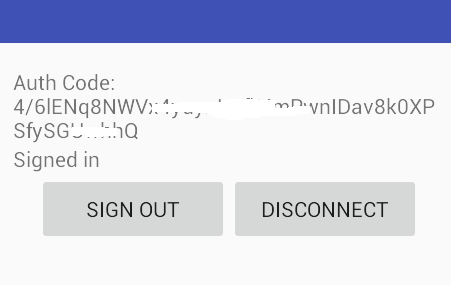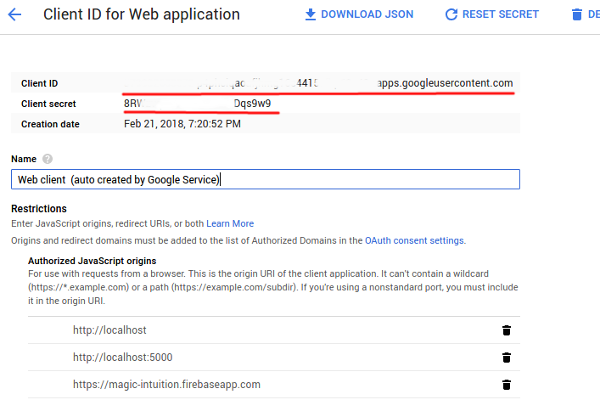For your requirements, you can use the following code:
Firstly, make sure you have a valid Web OAuth 2.0 Client ID:
<!-- Server Client ID. This should be a valid Web OAuth 2.0 Client ID obtained
from https://console.developers.google.com/ -->
<string name="server_client_id">...e4p8.apps.googleusercontent.com</string>
Then inside Activity class:
@Override
public void onCreate(Bundle savedInstanceState) {
super.onCreate(savedInstanceState);
setContentView(R.layout.activity_main);
...
// For sample only: make sure there is a valid server client ID.
validateServerClientID();
// [START configure_signin]
// Configure sign-in to request offline access to the user's ID, basic
// profile, and Google Drive. The first time you request a code you will
// be able to exchange it for an access token and refresh token, which
// you should store. In subsequent calls, the code will only result in
// an access token. By asking for profile access (through
// DEFAULT_SIGN_IN) you will also get an ID Token as a result of the
// code exchange.
String serverClientId = getString(R.string.server_client_id);
GoogleSignInOptions gso = new GoogleSignInOptions.Builder(GoogleSignInOptions.DEFAULT_SIGN_IN)
.requestScopes(new Scope(Scopes.DRIVE_APPFOLDER))
.requestServerAuthCode(serverClientId)
.requestEmail()
.build();
// [END configure_signin]
// Build GoogleAPIClient with the Google Sign-In API and the above options.
mGoogleApiClient = new GoogleApiClient.Builder(this)
.enableAutoManage(this /* FragmentActivity */, this /* OnConnectionFailedListener */)
.addApi(Auth.GOOGLE_SIGN_IN_API, gso)
.build();
}
private void getAuthCode() {
// Start the retrieval process for a server auth code. If requested, ask for a refresh
// token. Otherwise, only get an access token if a refresh token has been previously
// retrieved. Getting a new access token for an existing grant does not require
// user consent.
Intent signInIntent = Auth.GoogleSignInApi.getSignInIntent(mGoogleApiClient);
startActivityForResult(signInIntent, RC_GET_AUTH_CODE);
}
@Override
public void onActivityResult(int requestCode, int resultCode, Intent data) {
super.onActivityResult(requestCode, resultCode, data);
if (requestCode == RC_GET_AUTH_CODE) {
GoogleSignInResult result = Auth.GoogleSignInApi.getSignInResultFromIntent(data);
Log.d(TAG, "onActivityResult:GET_AUTH_CODE:success:" + result.getStatus().isSuccess());
if (result.isSuccess()) {
// [START get_auth_code]
GoogleSignInAccount acct = result.getSignInAccount();
String authCode = acct.getServerAuthCode();
// Show signed-in UI.
mAuthCodeTextView.setText(getString(R.string.auth_code_fmt, authCode));
updateUI(true);
// TODO(user): send code to server and exchange for access/refresh/ID tokens.
// [END get_auth_code]
} else {
// Show signed-out UI.
updateUI(false);
}
}
}
You can see the entire code at the following ServerAuthCodeActivity.java
The result, if you use that sample, looks like the following screenshot:
![BNK's screenshot]()
Then, you can follow the steps mentioned at the Google's documentation below (from step #3. Send the auth code to your app's backend using HTTPS POST):
Google Sign-In for Android - Enabling Server-Side Access
UPDATE: from the comments, if you want to get access token directly from android client app, please use the following sample code (replaced with your client_id, client_secret and the auth code)
OkHttpClient client = new OkHttpClient();
RequestBody requestBody = new FormEncodingBuilder()
.add("grant_type", "authorization_code")
.add("client_id", "812741506391-h38jh0j4fv0ce1krdkiq0hfvt6n5amrf.apps.googleusercontent.com")
.add("client_secret", "{clientSecret}")
.add("redirect_uri","")
.add("code", "4/4-GMMhmHCXhWEzkobqIHGG_EnNYYsAkukHspeYUk9E8")
.build();
final Request request = new Request.Builder()
.url("https://www.googleapis.com/oauth2/v4/token")
.post(requestBody)
.build();
client.newCall(request).enqueue(new Callback() {
@Override
public void onFailure(final Request request, final IOException e) {
Log.e(LOG_TAG, e.toString());
}
@Override
public void onResponse(Response response) throws IOException {
try {
JSONObject jsonObject = new JSONObject(response.body().string());
final String message = jsonObject.toString(5);
Log.i(LOG_TAG, message);
} catch (JSONException e) {
e.printStackTrace();
}
}
});
Please use compile 'com.squareup.okhttp:okhttp:2.6.0' (ver 3-RC1 will have different classes)
With a sucessful response, you will have the following info in logcat:
I/onResponse: {
"expires_in": 3600,
"token_type": "Bearer",
"refresh_token": "1\/xz1eb0XU3....nxoALEVQ",
"id_token": "eyJhbGciOiJSUzI1NiIsImtpZCI6IjQxMWY1Ym......yWVsUA",
"access_token": "ya29.bQKKYah-........_tkt980_qAGIo9yeWEG4"
}



getServerAuthCode()gets you a one time Auth Code which you upload to your server. The your server requests AccessToken using the auth code. – Duval